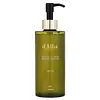What's inside
What's inside
 Key Ingredients
Key Ingredients

 Benefits
Benefits

 Concerns
Concerns

 Ingredients Side-by-side
Ingredients Side-by-side

Water
Skin ConditioningGlycerin
HumectantDisodium Cocoamphodiacetate
CleansingCoco-Glucoside
CleansingLauryl Glucoside
CleansingSodium Chloride
MaskingTea-Cocoyl Glutamate
CleansingAcrylates/C10-30 Alkyl Acrylate Crosspolymer
Emulsion StabilisingHexylene Glycol
EmulsifyingCitric Acid
BufferingChlorphenesin
AntimicrobialLavandula Angustifolia Oil
MaskingEthylhexylglycerin
Skin ConditioningButylene Glycol
HumectantXanthan Gum
EmulsifyingBetaine Salicylate
AntimicrobialSaccharide Isomerate
Humectant1,2-Hexanediol
Skin ConditioningCaprylyl Glycol
EmollientSalvia Officinalis Leaf Extract
CleansingSalix Alba Bark Extract
AstringentRosmarinus Officinalis Leaf Extract
AntimicrobialMentha Piperita Leaf Extract
Skin ConditioningLavandula Angustifolia Flower Extract
CleansingCarica Papaya Fruit Extract
Skin ConditioningAcetyl Hexapeptide-8
HumectantTuber Magnatum Extract
Skin ConditioningSodium Citrate
BufferingChamomilla Recutita Flower Extract
MaskingOcimum Basilicum Flower/Leaf/Stem Extract
TonicMelissa Officinalis Leaf Extract
Skin ConditioningMonarda Didyma Leaf Extract
Skin ConditioningMentha Suaveolens Leaf Extract
AstringentHibiscus Sabdariffa Flower Extract
Skin ConditioningRosa Centifolia Flower Extract
AstringentMentha Rotundifolia Leaf Extract
TonicLinalool
PerfumingWater, Glycerin, Disodium Cocoamphodiacetate, Coco-Glucoside, Lauryl Glucoside, Sodium Chloride, Tea-Cocoyl Glutamate, Acrylates/C10-30 Alkyl Acrylate Crosspolymer, Hexylene Glycol, Citric Acid, Chlorphenesin, Lavandula Angustifolia Oil, Ethylhexylglycerin, Butylene Glycol, Xanthan Gum, Betaine Salicylate, Saccharide Isomerate, 1,2-Hexanediol, Caprylyl Glycol, Salvia Officinalis Leaf Extract, Salix Alba Bark Extract, Rosmarinus Officinalis Leaf Extract, Mentha Piperita Leaf Extract, Lavandula Angustifolia Flower Extract, Carica Papaya Fruit Extract, Acetyl Hexapeptide-8, Tuber Magnatum Extract, Sodium Citrate, Chamomilla Recutita Flower Extract, Ocimum Basilicum Flower/Leaf/Stem Extract, Melissa Officinalis Leaf Extract, Monarda Didyma Leaf Extract, Mentha Suaveolens Leaf Extract, Hibiscus Sabdariffa Flower Extract, Rosa Centifolia Flower Extract, Mentha Rotundifolia Leaf Extract, Linalool
Water
Skin ConditioningSodium Cocoyl Isethionate
CleansingGlycerin
HumectantHydroxypropyl Starch Phosphate
Sodium Methyl Cocoyl Taurate
CleansingDecyl Glucoside
CleansingPotassium Cocoyl Glycinate
Cetearyl Alcohol
EmollientGlyceryl Stearate
EmollientSorbitan Olivate
EmulsifyingGlycol Distearate
EmollientPotassium Cocoate
EmulsifyingCaprylyl Glycol
EmollientCitric Acid
BufferingPolyquaternium-67
Glyceryl Caprylate
EmollientDisodium EDTA
Sodium Acetate
BufferingSodium Chloride
MaskingPanthenol
Skin ConditioningPentylene Glycol
Skin ConditioningMadecassoside
AntioxidantWater, Sodium Cocoyl Isethionate, Glycerin, Hydroxypropyl Starch Phosphate, Sodium Methyl Cocoyl Taurate, Decyl Glucoside, Potassium Cocoyl Glycinate, Cetearyl Alcohol, Glyceryl Stearate, Sorbitan Olivate, Glycol Distearate, Potassium Cocoate, Caprylyl Glycol, Citric Acid, Polyquaternium-67, Glyceryl Caprylate, Disodium EDTA, Sodium Acetate, Sodium Chloride, Panthenol, Pentylene Glycol, Madecassoside
 Reviews
Reviews

Ingredients Explained
These ingredients are found in both products.
Ingredients higher up in an ingredient list are typically present in a larger amount.
Caprylyl Glycol is a humectant and emollient, meaning it attracts and preserves moisture.
It is a common ingredient in many products, especially those designed to hydrate skin. The primary benefits are retaining moisture, skin softening, and promoting a healthy skin barrier.
Though Caprylyl Glycol is an alcohol derived from fatty acids, it is not the kind that can dry out skin.
This ingredient is also used as a preservative to extend the life of products. It has slight antimicrobial properties.
Learn more about Caprylyl GlycolCitric Acid is an alpha hydroxy acid (AHA) naturally found in citrus fruits like oranges, lemons, and limes.
Like other AHAs, citric acid can exfoliate skin by breaking down the bonds that hold dead skin cells together. This helps reveal smoother and brighter skin underneath.
However, this exfoliating effect only happens at high concentrations (20%) which can be hard to find in cosmetic products.
Due to this, citric acid is usually included in small amounts as a pH adjuster. This helps keep products slightly more acidic and compatible with skin's natural pH.
In skincare formulas, citric acid can:
While it can provide some skin benefits, research shows lactic acid and glycolic acid are generally more effective and less irritating exfoliants.
Most citric acid used in skincare today is made by fermenting sugars (usually from molasses). This synthetic version is identical to the natural citrus form but easier to stabilize and use in formulations.
Read more about some other popular AHA's here:
Learn more about Citric AcidGlycerin is already naturally found in your skin. It helps moisturize and protect your skin.
A study from 2016 found glycerin to be more effective as a humectant than AHAs and hyaluronic acid.
As a humectant, it helps the skin stay hydrated by pulling moisture to your skin. The low molecular weight of glycerin allows it to pull moisture into the deeper layers of your skin.
Hydrated skin improves your skin barrier; Your skin barrier helps protect against irritants and bacteria.
Glycerin has also been found to have antimicrobial and antiviral properties. Due to these properties, glycerin is often used in wound and burn treatments.
In cosmetics, glycerin is usually derived from plants such as soybean or palm. However, it can also be sourced from animals, such as tallow or animal fat.
This ingredient is organic, colorless, odorless, and non-toxic.
Glycerin is the name for this ingredient in American English. British English uses Glycerol/Glycerine.
Learn more about GlycerinChances are, you eat sodium chloride every day. Sodium Chloride is also known as table salt.
This ingredient has many purposes in skincare: thickener, emulsifier, and exfoliator.
You'll most likely find this ingredient in cleansers where it is used to create a gel-like texture. As an emulsifier, it also prevents ingredients from separating.
There is much debate on whether this ingredient is comedogenic. The short answer - comedogenic ratings don't tell the whole story. Learn more about comegodenic ratings here.
The concensus about this ingredient causing acne seems to be divided. Research is needed to understand if this ingredient does cause acne.
Scrubs may use salt as the primary exfoliating ingredient.
Learn more about Sodium ChlorideWater. It's the most common cosmetic ingredient of all. You'll usually see it at the top of ingredient lists, meaning that it makes up the largest part of the product.
So why is it so popular? Water most often acts as a solvent - this means that it helps dissolve other ingredients into the formulation.
You'll also recognize water as that liquid we all need to stay alive. If you see this, drink a glass of water. Stay hydrated!
Learn more about Water